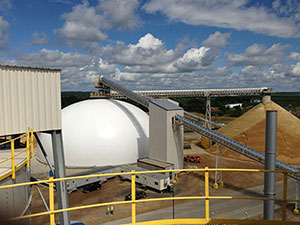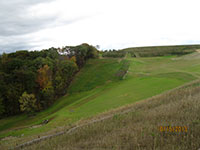Industrial sand mining - information for industry
Recent growth in the petroleum and sand mining industries has created a high demand for Wisconsin sand used for hydraulic fracturing. The DNR has seen a substantial rise in permit requests to the department to mine industrial sand.
Due to this demand, the department has created this page specifically for the sand mining industry to help with permit applications, navigating state regulations and for other additional business support.
Before you apply, please contact Roberta Walls.
Overview of process
The following information is available to sand mining operations regarding the overall process in various programs for obtaining a permit.
Air permits
Groundwater
Natural Heritage Inventory (NHI)
Stormwater
Waterways
Wetlands
Permit Primer
As a Wisconsin business owner, managing your business – big or small – often requires you to work with state government to follow laws and regulations as well as obtain several different permits. Sometimes the number and complexity of rules, regulations and permits can be overwhelming. The DNR has created a number of interactive permit web pages to help business owners understand their legal requirements and manage their environmental responsibilities.
Before you apply, please contact Roberta Walls.
Air permits and variance process
Industrial sand mines subject to ch. NR 415.075(4), Wis. Adm. Code, are required to perform ambient monitoring for particulates unless they have applied for and received a variance through the variance process.
Groundwater
Storm water
Waterways
Wetlands
In addition to other state permits, county and local governments may be responsible for regulating mine operations other than reclamation activities. Under ch. NR 135, Wis. Adm. Code, the DNR Nonmetallic Mining Program is responsible for ensuring uniform statewide implementation of nonmetallic mining reclamation requirements. It does this by overseeing county and local reclamation programs, known as regulatory authorities (RAs). The DNR provides technical assistance to these programs and audits them periodically to ensure they are administering reclamation programs in a uniform and reasonable manner across the state. A stakeholder group, the Nonmetallic Mining Advisory Committee, advises the DNR on its administration of the statewide reclamation program.
State laws and regulations
What about fugitive dust?
Industrial sand mine sources that will have the capacity to produce more than 2,000 tons/month on a 12-month averages basis must also submit fugitive dust plans to the DNR as part of the air permitting process.
How does the state regulate small mines and dust?
Some very small mines must still comply with dust rules in NR 415, Wis. Adm. Code., but they may be exempt from air permitting or submitting a written plan for dealing with fugitive dust.
Does the DNR regulate chemical washes?
A review of chemicals used to clean recycled water from the industrial sand mining process are regulated as part of a DNR storm water permit. Flocculants being used need to be identified in the storm water permit application.
Enforcement and compliance
How does the compliance/enforcement process work?
The department utilizes a stepped enforcement process. That process begins with DNR issuing a "Notice of Violation" (NOV) or a "Notice of Noncompliance" (NON) and may be followed up with an enforcement conference held by DNR Environmental Enforcement Program staff. Also, the department has the option of referral to the Department of Justice to seek forfeitures and court-ordered corrective actions if appropriate or necessary.
Throughout these steps, the regulated entity is provided with direction on what violations have been identified and given a timeframe in which to correct those violations. Also, these steps can be skipped or repeated at any point depending on the specifics of the situation.
In some instances, we also have civil citation authority with the assistance of the DNR's wardens. Citations are tried through the local court systems.
What compliance issues have occurred in the sand mining industry?
Issues include: starting construction/operations without permits; failing to follow permit requirements; storm water run-off/discharge issues; fugitive dust; some wetland issues and failure to abandon or properly abandon exploratory boreholes.
How does this industry compare to others in terms of compliance issues?
The industrial sand industry has been around a long time, and sand mining is a facet of the industry that focuses on a particular quality of sand. As with other industries that experience rapid expansion, compliance issues can result from the pressure to move quickly to meet demand or from new people entering the business who are not familiar with the rules and regulations pertaining to the industry.
Why do some violations lead to citation or referrals, and not others?
Each case is evaluated on an individual basis and enforcement decisions are made using a number of factors, including the actual or potential impact on human health and the environment; nature or toxicity of the pollutant; number and duration of violations; compliance history; and responsiveness to correcting the violations.
Why are there so many more water violations than air quality violations?
There are a number of water-related laws that apply to this industry. For example, water regulations apply to proper abandonment of exploratory boreholes, erosion control and storm water management, work in or near waterways, wetlands protection, de-watering of mining areas and wastewater generated from "washing" sand as part of processing the material.
Air issues, while no less important, have so far tended to be fewer in number and compliance problems have largely been associated with fugitive emissions control – keeping dust from blowing off-site, for example – and proper construction of or emissions from processing equipment.
Abandonment of exploratory drill holes
What are the requirements for abandoning an exploratory drill hole?
State code Chapter NR 812, Wis. Adm. Code, addresses filling and sealing requirements for exploratory drill holes. The code specifies a drill hole be properly filled and sealed no later than 90 days after the drill hole is removed from service. However, DNR encourages drillers to fill and seal drill holes immediately to avoid soil collapses and bridging.
What forms must be completed?
Contractors must submit a Well/Drillhole/Borehole Filling & Sealing Report (3300-005) to DNR.
What happens if drill holes are not properly abandoned? (3300-005)
Contact information
For information on industrial sand mining, contact:
For air compliance information at specific facilities, contact:


